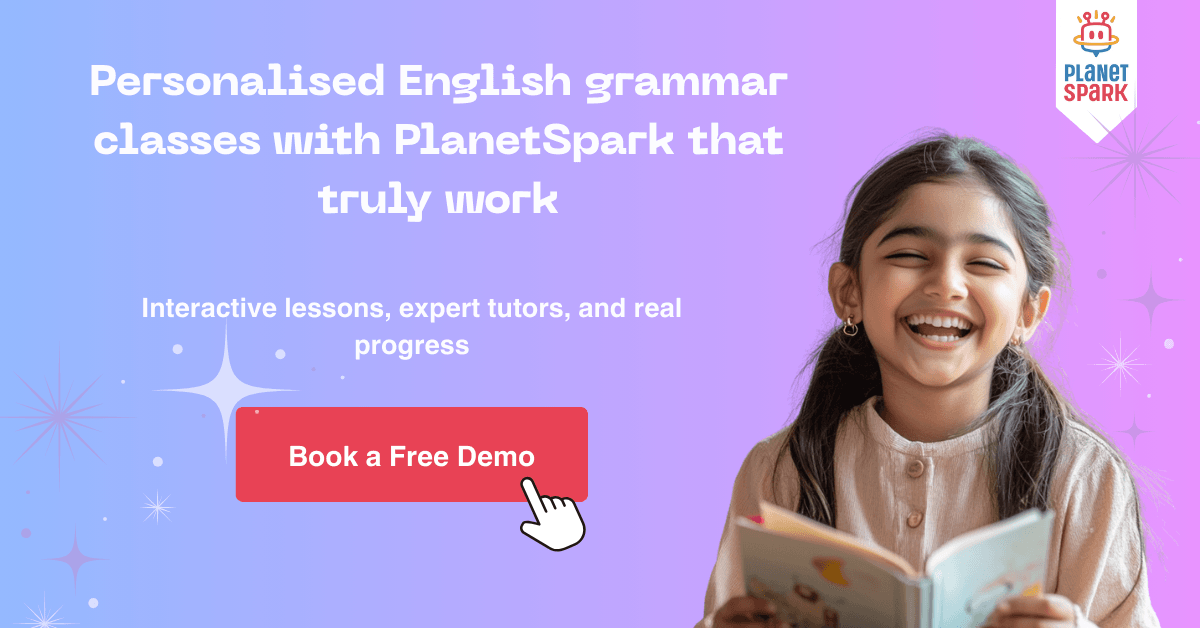Its vs It’s for Beginners: Simple Rules and Examples

Table of Contents
- Its vs. It's: Meaning of “Its”
- Its vs. It's: Meaning of “It's”
- Its vs It’s: Side-by-Side Comparison
- Common Mistakes People Make with Its and It’s
- Tricks and Memory Hacks to Remember the Difference
- Master Grammar Confusions like Its vs It’s with PlanetSpark
- Conclusion
- Readers Also Read
- FAQs About Its vs It’s
English grammar can be tricky, and one of the most common sources of confusion is the difference between “its” and “it’s.” At first glance, they may look almost identical, but a tiny apostrophe changes the meaning completely. In fact, even fluent writers and native speakers often slip up when choosing between the two.
Mastering the use of its vs it’s is not just about passing grammar tests, it’s about writing clearly, professionally, and with confidence. In this guide, we’ll break down the differences, share easy tips, and give you practice exercises to avoid this grammar pitfall.
Its vs. It's: Meaning of “Its”
The word “its” is the possessive form of “it”, and it is used to show ownership or belonging. In simple terms, when something belongs to or is a part of “it,” we use its. Think of it as similar to words like his, her, your, or their, which also show possession.
For example:
The dog wagged its tail.
Here, the tail belongs to the dog, so we use its.The company increased its profits.
The profits belong to the company, so its correctly shows possession.
Notice that there is no apostrophe in its. This is where many learners get confused, because normally in English, possession is shown with an apostrophe (e.g., the boy’s book). But its is an exception. In this case, adding an apostrophe actually makes the word incorrect.
Give Your Child Confidence in English
Schedule a PlanetSpark Demo Now!
Common Phrases Using “Its”
Every country has its own traditions.
The phone has lost its signal.
The tree shed its leaves in autumn.
These examples highlight how its naturally fits whenever we are talking about something that belongs to a person, place, object, or idea that has already been referred to as it.
When Not to Confuse with “It’s”
One of the most common mistakes is writing it’s (with an apostrophe) when you really mean its. Remember:
Its = possession.
It’s = contraction of it is or it has.
Test it out: If you can replace the word with his or her, then its is the right choice. For example:
The cat licked its paw. (You could also say, The cat licked her paw. That works, so its is correct.)
On the other hand, if you try to replace its with it is and it doesn’t make sense, then you should avoid the apostrophe.
Quick Tip
Think of its like his or her. Just like you wouldn’t write hi’s when showing possession, you shouldn’t write it’s when you mean ownership.
In short, its is a possessive pronoun that makes sentences clear and grammatically correct. By keeping this small but important rule in mind, you’ll avoid one of the most common grammar pitfalls.
Its vs. It's: Meaning of “It's”
The word “it’s” is a contraction, which means it is formed by combining two words into one shorter version. Specifically, it’s can stand for either “it is” or “it has.” The apostrophe here replaces the missing letter or letters. Unlike its (the possessive form), it’s always contains an apostrophe and never shows ownership.
Breaking Down Both Cases
It’s = It is
In many sentences, it’s simply replaces it is. For example:It’s raining outside. → (It is raining outside.)
It’s a beautiful day. → (It is a beautiful day.)
It’s not easy to learn a new language. → (It is not easy to learn a new language.)
In each of these examples, you could expand it’s to it is without changing the meaning.
It’s = It has
Sometimes, it’s stands for it has, usually in the context of perfect tenses. For example:It’s been a long day. → (It has been a long day.)
It’s already finished the job. → (It has already finished the job.)
It’s taken me hours to solve this problem. → (It has taken me hours to solve this problem.)
Notice how in these examples, replacing it’s with it has makes sense and fits the meaning.
Sentence Examples and Explanations
It’s amazing how quickly children learn. → Here, it’s = it is.
It’s been years since we last met. → Here, it’s = it has.
I can’t believe it’s already December. → Here, it’s = it is.
It’s grown so much since last year. → Here, it’s = it has.
In all these cases, it’s is never possessive. It does not show ownership, but rather shortens a phrase to make writing and speaking smoother.
Tip to Check Correctness
One of the easiest ways to avoid confusion is to expand “it’s.” Whenever you write it’s, try replacing it with it is or it has.
If the sentence still makes sense → it’s is correct.
If it doesn’t make sense → you probably meant its (the possessive form).
For example:
The dog wagged it’s tail. → Expand: The dog wagged it is tail. ❌ Doesn’t make sense. → Wrong.
It’s going to snow tomorrow. → Expand: It is going to snow tomorrow. ✅ Makes sense. → Correct.
Quick Reminder
It’s = contraction (it is or it has).
Its = possessive (shows ownership).
By remembering this simple expansion trick, you’ll always know when to use it’s correctly and avoid one of the most common grammar errors in English.

Its vs It’s: Side-by-Side Comparison
Now that we’ve looked at its and it’s separately, let’s compare them directly. At first glance, they look almost identical, but their meanings and usage are completely different. Remember: the apostrophe is the game-changer.
Here’s a simple comparison chart to help you spot the difference quickly:
| Word | Definition | Example Sentence | Expanded Form Test |
| Its (no apostrophe) | Possessive form of it → shows ownership | The cat licked its paw. | Replace with his or her → The cat licked her paw. (✔ Correct) |
| It’s (with apostrophe) | Contraction of it is or it has | It’s going to rain. → It is going to rain. | Replace with it is / it has → Makes sense (✔ Correct) |
How to Decide Which One to Use
If you mean possession → use its.
The company is proud of its achievements.
Every season has its beauty.
If you mean it is or it has → use it’s.
It’s a pleasure to meet you. (It is a pleasure to meet you.)
It’s been a tough week. (It has been a tough week.)
Quick Test Method
Whenever you’re unsure, try this simple trick:
Replace the word with it is or it has.
If the sentence makes sense → the correct word is it’s.
If the sentence doesn’t make sense → the correct word is its.
Example 1
Wrong: The dog wagged it’s tail.
Test: The dog wagged it is tail. (Incorrect)
Correct: The dog wagged its tail.
Example 2
Sentence: It’s been a wonderful trip.
Test: It has been a wonderful trip. (✔ Correct)
Correct: It’s been a wonderful trip.
Why Writers Often Mix Them Up
Many learners assume that possessives always need an apostrophe, as in the boy’s book or the teacher’s desk. But its breaks this pattern because English reserves the apostrophe for contractions in this case, not possession. That’s why “its” without an apostrophe is the correct possessive form.
Key Takeaway
Its = possession (like his, her, their).
It’s = contraction (it is / it has).
If you’re ever in doubt, remember this golden rule: “Expand it out.” If you can replace the word with it is or it has, then the apostrophe belongs there. If not, use its.
Learn Its vs It’s and More
Reserve Your Free PlanetSpark Demo!
Common Mistakes People Make with Its and It’s
Even though the difference between its and it’s is simple once you understand it, many learners, and even experienced writers, still get them mixed up. The confusion usually comes from the role of the apostrophe. Since apostrophes are normally used for possession (the teacher’s book), people assume its should work the same way. Let’s explore the most common errors.
1. Using it’s instead of its for Possession
Wrong: The company increased it’s revenue this year.
Correct: The company increased its revenue this year.
Why the mistake happens: Writers assume that because “company’s” or “teacher’s” uses an apostrophe, its should too. But remember, its is already the possessive form, and it doesn’t need an apostrophe.
2. Using its Instead of it’s for Contractions
Wrong: Its going to rain tomorrow.
Correct: It’s going to rain tomorrow. (It is going to rain tomorrow.)
Why the mistake happens: Writers forget to include the apostrophe when shortening it is. This makes the sentence look incomplete and grammatically incorrect.
3. Adding an Extra Apostrophe (its’)
Wrong: The bird built its’ nest in the tree.
Correct: The bird built its nest in the tree.
Why the mistake happens: People try to blend possession and apostrophe rules, creating a form (its’) that doesn’t exist in English. There is no situation where its’ is correct.
4. Forgetting to Expand It’s Before Using It
Wrong: The dog wagged it’s tail.
Expanded Test: The dog wagged it is tail. Incorrect.
Correct: The dog wagged its tail.
Why the mistake happens: Writers skip the “expand it out” test and insert it’s by habit. Expanding the contraction is the quickest way to catch this error.
5. Confusing Formal vs. Informal Writing
In formal writing (like academic essays or business reports), contractions such as it’s are often avoided. Writers sometimes overcorrect and end up replacing every instance of it’s with its, even when it’s wrong.
Wrong (formal essay): Its been proven that exercise improves health.
Correct (formal essay): It has been proven that exercise improves health.
(In this case, instead of it’s, write out it has for formal tone.)
Quick Tips to Avoid Mistakes
Always expand it’s to it is or it has to check if it works.
If the meaning is possession, use its without an apostrophe.
Remember, its’ is never correct.
Tricks and Memory Hacks to Remember the Difference
Understanding the rule is one thing, but remembering it while writing can be another challenge. Here are some simple tricks and memory hacks to help you keep its and it’s straight in your mind.
1. The Expansion Test
Every time you write it’s, try expanding it into it is or it has.
If the sentence makes sense, then it’s is correct.
If it doesn’t make sense, you should use its.
Example:
It’s raining outside. → It is raining outside. Correct.
The dog wagged it’s tail. → The dog wagged it is tail. Incorrect, so the right word is its.
2. Think of its Like his or her
Possessive pronouns like his and her do not take an apostrophe. In the same way, its also shows possession without an apostrophe.
The bird built its nest.
You wouldn’t write hi’s nest or he’s nest when showing possession, so don’t write it’s nest.
3. The Apostrophe Rule Shortcut
Ask yourself: “Does the apostrophe replace a missing letter?”
In it’s, the apostrophe replaces the missing “i” in is or the “ha” in has.
In its, there is no missing letter, so no apostrophe is needed.
4. Avoid the Nonexistent its’
Remember, its’ with the apostrophe at the end is never correct. If you find yourself writing it, you are mixing up the two rules. Stop and check whether you mean possession (its) or contraction (it’s).
5. Practice Makes It Natural
Create your own sentences using both forms. For example:
The company released its annual report.
It’s been a successful year for the company.
By practicing side-by-side examples, the difference will soon become second nature.

Master Grammar Confusions like Its vs It’s with PlanetSpark
Mixing up “its” and “it’s” is one of the most common grammar mistakes. At PlanetSpark, children learn grammar through stories, dialogues, and interactive exercises, not rote memorization. This ensures tricky rules, like when to use its as a possessive and it’s as a contraction, are easy to understand and apply.
How PlanetSpark Helps
Concept to Application: Learn rules → examples → sentences → paragraphs → live corrections.
Gamified Learning: Fun quizzes, puzzles, and games reinforce concepts like its vs it’s.
Integrated Writing Practice: Kids immediately apply what they learn in sentences and short paragraphs.
Progress Tracking: Parents get reports on grammar skills, including writing accuracy and usage of contractions and possessives.
With PlanetSpark, learners confidently master grammar and avoid common errors like its vs it’s.
Conclusion
Understanding the difference between its and it’s is a small but essential part of writing clearly and professionally. Its shows possession, while it’s is a contraction of it is or it has. Many writers make mistakes because of the tricky apostrophe rules, but with simple tests, practice, and usage-based learning, you can master this once and for all.
By following the tips, memory hacks, and exercises shared in this guide, and with tools like PlanetSpark to reinforce grammar concepts, learners can confidently avoid errors, improve writing fluency, and communicate accurately. Remember: when in doubt, expand it’s to it is or it has, if it works, the apostrophe belongs; if not, use its.
Readers Also Read
To further strengthen your understanding of English grammar and avoid common mistakes like its vs it’s, explore these helpful resources from PlanetSpark:
Types of Sentences
Learn how to construct clear and varied sentences, simple, compound, and complex, to express your ideas effectively.Singular and Plural Nouns
Master the rules for forming singular and plural nouns, ensuring grammatical accuracy in your writing.
FAQs About Its vs It’s
1. What is the difference between “its” and “it’s”?
Its is possessive (shows ownership), while it’s is a contraction for it is or it has.
2. Can “its” ever mean “it is”?
No, its only shows possession. Use it’s for it is or it has.
3. Why doesn’t “its” have an apostrophe if it’s possessive?
Unlike other possessives (like John’s), its is a special case in English and never takes an apostrophe.
4. How can I avoid confusing its and it’s in writing?
Use the “expand it’s” test: replace it with it is or it has. If the sentence makes sense, use it’s; otherwise, use its.
5. Is “its’” ever correct?
No, its’ is always incorrect. The possessive form of it is simply its.
6. Can PlanetSpark help my child master “its vs it’s”?
Yes, PlanetSpark uses interactive grammar lessons, games, and writing exercises to help children practice and confidently use contractions and possessives like its vs it’s.
Download Free Worksheets
Personalized Communication Report
Record a video to get a AI generated personalized communication report for your child

Hi There, want to try these
tips for your child with
LIVE with our expert coach?
Let's check your child's
English fluency

